The Art of Counterstrain: How This Manual Therapy Works Wonders
Your Guide to a Gentle Path for Pain Relief
Strain and counterstrain is a gentle manual therapy technique that helps relieve muscle tension and pain by positioning your body into comfortable positions that allow tight tissues to naturally relax and reset. It works with your body's recovery mechanisms, not against them.
Quick Overview of Strain and Counterstrain:
What it is: A passive positioning technique that finds tender points and moves the body to reduce strain.
How it works: Holds comfortable positions for 90 seconds to reset muscle reflexes.
Who developed it: Dr. Lawrence Jones in 1955.
What it addresses: Chronic pain, headaches, fibromyalgia, sciatica, and is often used for conditions that haven't responded to other treatments.
Patient experience: A gentle process designed to be painless, often providing noticeable relief.
The beauty of this approach lies in its gentleness. There's no cracking, popping, or uncomfortable pressure, yet it can provide significant relief from pain that may have persisted for months or even years.
Hi! I'm Dr. Michelle Andrews, and I've used strain and counterstrain techniques extensively in my practice at ChiroHer to help patients find relief from chronic pain. This gentle approach is particularly effective for my prenatal patients and those with complex pain patterns.
What is Strain and Counterstrain?
At its core, strain and counterstrain is a manual therapy method that addresses musculoskeletal pain by gently guiding the body into positions of ease. Developed in 1955 by osteopathic physician Dr. Lawrence Jones, the technique was finded when he found that placing a patient in a comfortable position led to a spontaneous release of muscle tension.
The cornerstone of this therapy is identifying "tender points"—specific, small, and tender spots in muscles, tendons, or fascia. A practitioner locates a tender point and then carefully positions the patient's body to shorten the tissues around it. This "position of comfort" is held for about 90 seconds, allowing the muscle spasm to relax and inflammation to dissipate. The entire process is passive, with the patient relaxed while the practitioner does the work, aiming to restore joint mobility and reduce pain.
How is it Different from Other Manual Therapies?
While many manual therapies involve direct pressure or forceful adjustments, strain and counterstrain stands apart due to its indirect and gentle nature. Instead of pushing through restrictions, the approach is to move away from painful directions of motion.
Here's a quick comparison:
Feature Strain and Counterstrain Myofascial Release Soft Tissue Mobilization Technique Passive & Gentle (indirect) Direct & Moderate (sustained pressure) Direct & Moderate (rhythmic strokes, kneading) Goal Neurological reset, reflex relaxation, tissue "slack" Release fascial restrictions, improve tissue glide Reduce muscle tension, improve circulation, break adhesions Sensation Generally painless and comfortable; many patients report immediate relief Mild to moderate pressure, can be intense Varies, usually firm pressure, can be uncomfortable Force Applied Minimal to none, practitioner positions the patient Sustained pressure applied by practitioner Direct force applied by practitioner's hands/tools
The fundamental difference is the philosophy: strain and counterstrain works by relaxing the reflexes that cause muscle spasms, leading to an immediate reduction in muscle tone. It's about finding comfort to let the body reset itself, making it a reassuring option for those wary of more forceful therapies. You can learn more about various manual therapy techniques we use on our page, What is Manual Therapy in PT.
Understanding Strain and Counterstrain: Mechanisms and Applications
The Science Behind How Strain and Counterstrain Works
The secret to how this gentle technique creates significant effects lies in how it interacts with the body's interconnected systems. The main idea is the "Proprioceptive Theory," which suggests that after an injury, tiny sensors in your muscles (muscle spindles) can get stuck in "alarm mode," causing chronic muscle spasms. Strain and counterstrain gently positions the body to help quiet these overactive sensors, allowing the nervous system to calm and the muscles to relax.
The effects extend beyond just muscles, influencing several key systems:
Fascial System: It releases tension in the fascia, the web-like connective tissue wrapping every structure in your body. Tight fascia can cause pain and limit movement. Learn more about our work with Connective Tissue Manipulation.
Nervous System: By freeing up fascial restrictions around nerves, it helps restore proper nerve function, which can impact everything from shoulder pain to balance.
Lymphatic System: The technique helps restore the function of tiny pumps in your lymphatic vessels, improving your body's ability to drain inflammation and waste products.
Visceral System: It can also address the fascia around your organs, as tension there can be linked to musculoskeletal pain elsewhere in the body.
You can find detailed scientific information in resources like the Physiology of Counterstrain from the National Center for Biotechnology Information.
Conditions That May Benefit from This Technique
Because strain and counterstrain works with the body's natural recovery mechanisms, it can help with a wide range of issues, especially those that haven't responded to other treatments.
It is particularly helpful for:
Chronic Pain: Long-term neck and back pain may improve significantly.
Fibromyalgia: Can help manage widespread pain and tender points without causing more discomfort.
Headaches and Migraines: Can reduce the frequency and intensity by addressing tension in the head and neck.
Sciatica: Releasing tension along the sciatic nerve pathway can reduce radiating pain and numbness.
Post-Surgical Pain: Helps address lingering stiffness and scar tissue after surgery.
TMJ Dysfunction: Releasing fascial restrictions in the face and neck can help reduce jaw pain and clicking.
Pelvic Pain & Pregnancy: It's a gentle option often used for pelvic pain, especially during pregnancy, due to its non-invasive nature. Learn more on our Chiropractic Care and Pregnancy page.
Athletic Injuries: Helps support the recovery process from sprains and strains.
Complex Cases: Offers hope for individuals who have tried multiple other therapies without success.
The Patient Experience and Finding a Practitioner
What to Expect During a Strain and Counterstrain Session
A strain and counterstrain session is a deeply relaxing experience. The treatment is designed to be pain-free, and many patients notice a change in their symptoms right away. Here’s what a typical session involves:
Initial Assessment: We start by discussing your health history and pain patterns to understand how your body is being affected.
Identifying Tender Points: Using gentle pressure, we locate the small, specific spots of tension that are causing dysfunction.
Gentle Positioning: Once a tender point is found, we move your body into a "position of ease" where the tenderness disappears.
90-Second Hold: We hold this comfortable position for 90 seconds. You simply relax as your muscles "melt" and your nervous system calms.
Slow Return and Reassessment: We slowly bring you back to a neutral position and then re-check the tender point. Most patients are amazed to find the tenderness is significantly reduced or has disappeared.
Many people walk out feeling looser, more balanced, and with significantly less pain than when they arrived.
Finding a Qualified Practitioner
Since strain and counterstrain requires specialized training, it's important to find a qualified practitioner. Certification from reputable organizations like The Jones Institute or The Counterstrain Academy ensures your provider is skilled in the technique. You can use directories like the one from the Counterstrain Academy to find a certified practitioner near you.
At ChiroHer, our practitioners are skilled in various Manual Therapy techniques, including strain and counterstrain. We create personalized treatment plans in a comfortable, upscale environment.
If you're looking for a gentler approach to managing your discomfort, we'd love to help. Schedule a consultation to see if this technique is the right approach for you.
Hi! I'm Dr. Michelle Andrews, and I've seen positive results with strain and counterstrain in my practice. Watching a patient's pain decrease significantly in just 90 seconds is a beautiful reminder of how impactful gentle, patient-centered care can be.
Building Trust: Authority and Evidence
At ChiroHer, we believe in evidence-based practice, ensuring our treatments are supported by research and positive clinical outcomes. While strain and counterstrain has been used for nearly 70 years, recent scientific research has begun to provide a scientific basis for the effects observed by practitioners and patients.
Studies show that strain and counterstrain can provide meaningful, measurable improvements in patient outcomes. For example, research has shown that Positional Release Therapy (based on counterstrain principles) can be slightly more effective than therapeutic massage for reducing pain from trigger points.
Reputable sources like the National Center for Biotechnology Information (NCBI) provide detailed scientific information on the mechanisms behind the technique, such as the Physiology of Counterstrain. This research helps us understand how it may work on a neurological level.
We are committed to staying at the forefront of this research through continuing education and certification. This allows us to offer you effective, scientifically-informed care. The research supports what our patients often report: that it is a gentle technique that can provide relief, even when other approaches have not been successful.
This guide is for informational purposes and is not a substitute for already established medical advice from your healthcare provider.




